Today we're going to have a bit of a Really Right Stuff love-fest, as we look at the new camera L-Plates for the 5D Mark III and the completely re-designed L-Plate for the Canon EOS 1D X, as well as the TVC-34L Tripod with Leveling Base that I recently bought, and we can't do an RRS love-fest without giving their flagship ball-head, the BH-55 a mention. Use this audio player if you'd prefer to listen: [audio src="http://www.podtrac.com/pts/redirect.mp3?http://www.bokeaji.com/podcasts/mbpp_ep350.mp3" format="mp3"]
There are also download and subscription links at the end of the post.
In fact, I might as well start with the BH-55, as this has been my best friend for almost five years now. I'd used a number of ball-heads over the years, and as camera resolution increased, the flaws in my older ball-heads became apparent, and I'd look for something else.
I recall my friend Graham Morgan showing me his BH-55 on our first Hokkaido Workshop, and I also recall thinking just how beautiful a work of engineering art it was. He said it was the most solid ball-head he'd ever used, and of course, he was right. The BH-55 is rock solid. I bought mine within weeks of returning home from Hokkaido that year and haven't regretted it once.
The image below shows the BH-55 on top of my new Really Right Stuff TVC-34L Tripod with optional TA-3-LB Leveling Base, both of which we'll look at shortly. Really Right Stuff gear really are works of art, so I couldn't help sharing this first image from a series of black background shots that I made of this stuff. I shared the series of black background images on Google+ if you are interested, but for the rest of today's images, we'll use white background shots, to make it easier to see the gear.
[caption id="attachment_6459" align="aligncenter" width="590"]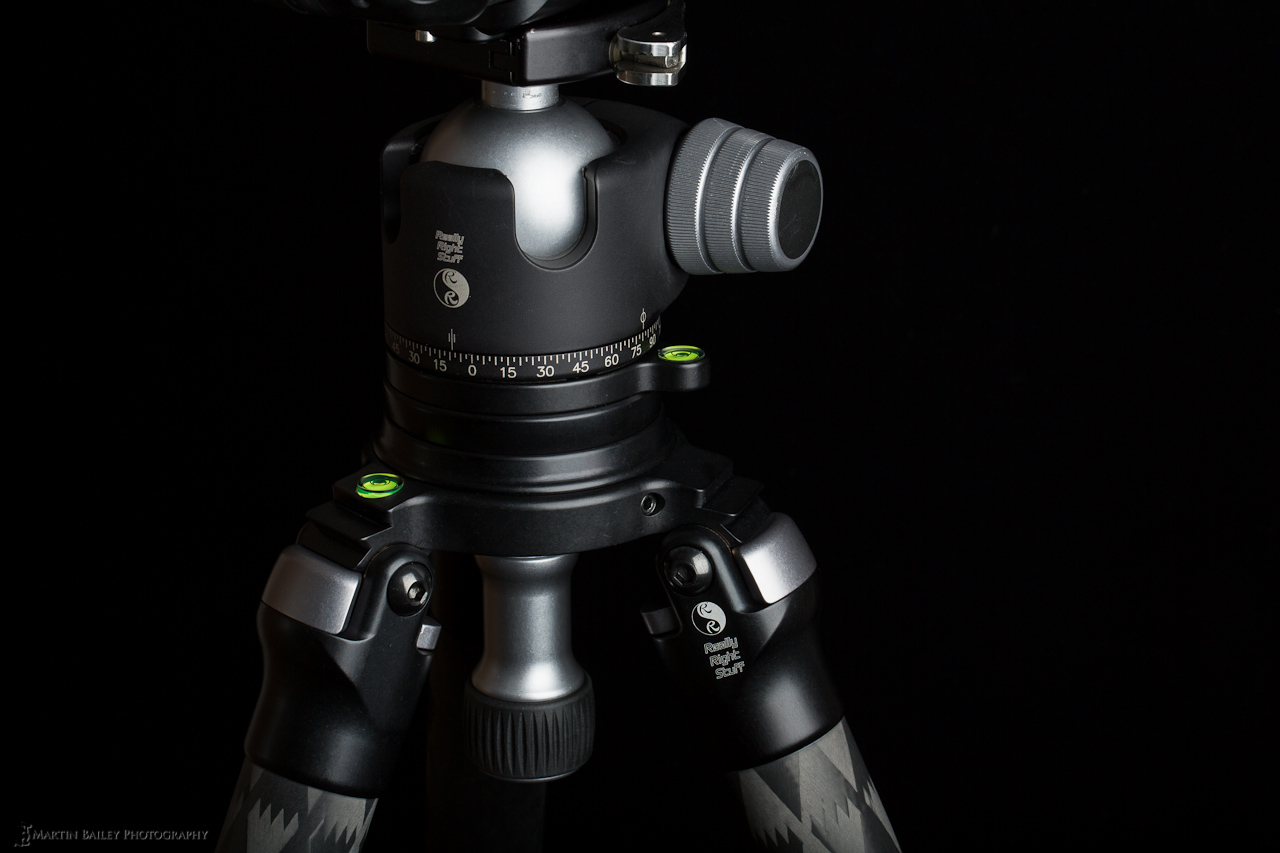 Really Right Stuff TVC-34L Tripod with Leveling Base and BH-55[/caption]
Really Right Stuff TVC-34L Tripod with Leveling Base and BH-55[/caption]
(Click on the image to view larger and navigate back and forth with your mouse or keyboard arrow keys.)
The BH-55 has three knurled knobs, starting with the largest one, which is to lock the ball in place, and believe me, when you tighten this up, that ball and camera are going nowhere!
[caption id="attachment_6462" align="alignright" width="341"]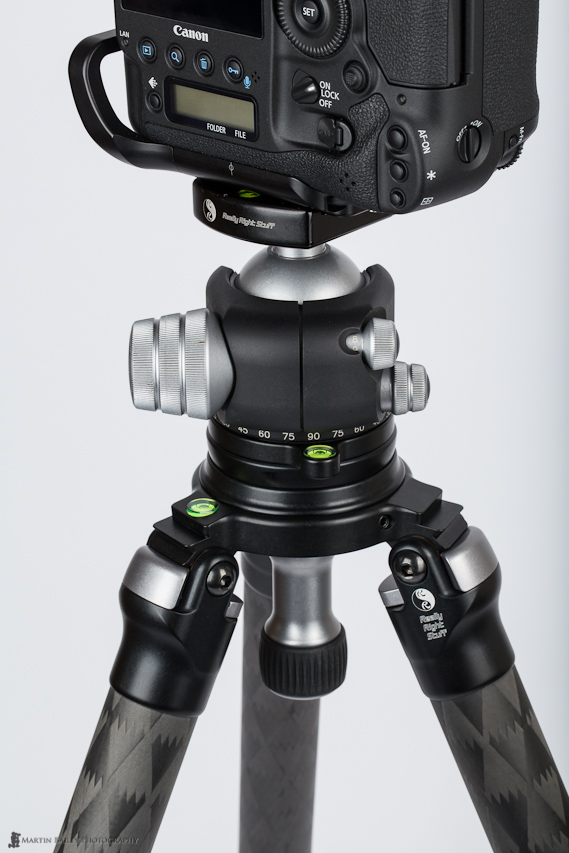 BH-55 Ball-Head Showing All Knobs[/caption]
BH-55 Ball-Head Showing All Knobs[/caption]
Of the two smaller knobs, the one at the bottom is to lock the horizontal movement, stopping the entire head from rotating. You use this to recompose when you need to move the camera horizontally across your scene.
If you have the tripod level, you can turn the camera on it's horizontal axis like this to take panorama photos. It's not going to be quite as accurate as setting it all up to rotate the camera around the No Parallax Point but today's stitching software is so advanced that I personally don't worry too much about that.
The top of the two small knobs is to control the drag or tension of the ball in its socket. This may not be an obvious benefit until you actually use it, but when I have this too slack, and undo the large locking knob, the camera flops around all over the place, making it hard to control. Adding just the right amount of tension to push back as I move the camera around makes fine turning so much easier.
You can tilt the ball-head and camera over and down into one of the two circular cut-outs on the head, which allows you to point the camera down further than the other positions, but you can also tilt the camera over on it's side using these openings, but that moves the center of gravity of the set up over to one side, and although it's still very stable, for best results, and for a number of other reasons, I chose to use L-Plates on my cameras, which enable me to unclamp the body, and switch orientation without tilting the camera on it's side.
Here (below) we see the new B1DX-L Plate for the Canon EOS 1D X that has been totally redesigned over the 1Ds Mark III L-Plate.
[caption id="attachment_6451" align="aligncenter" width="590"]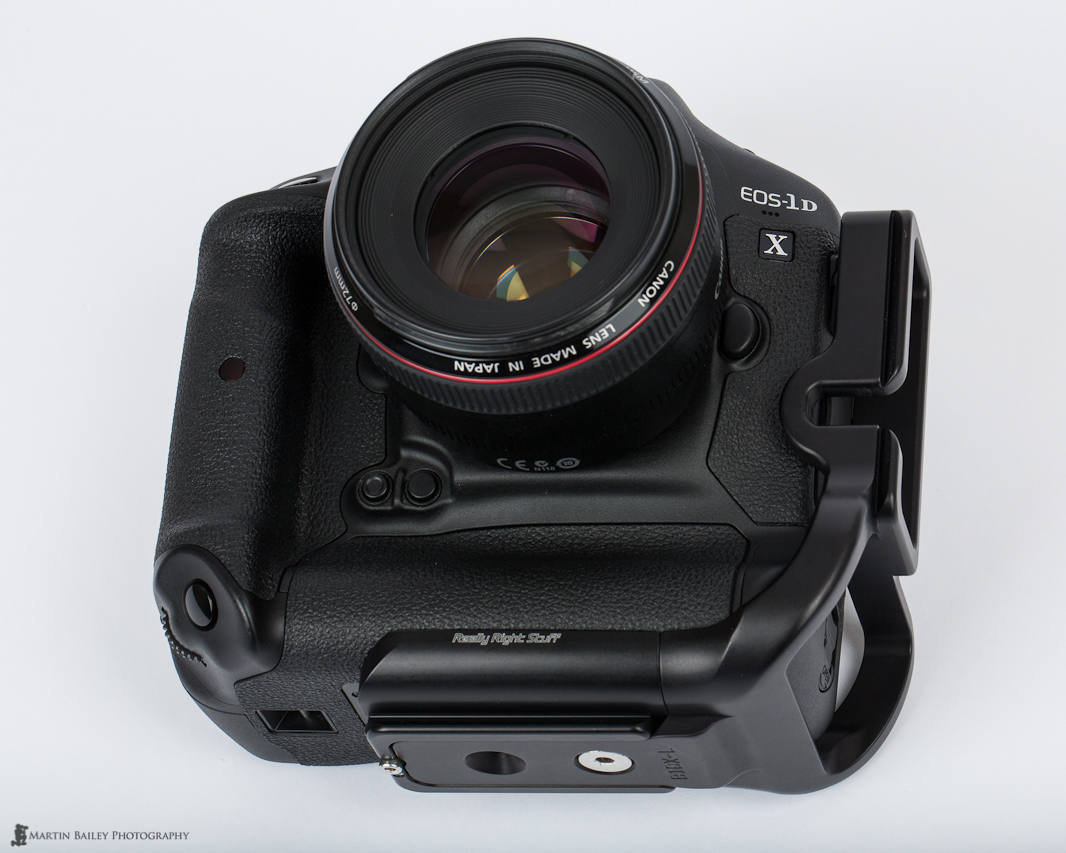 1D X with B1DX-L Plate Fitted[/caption]
1D X with B1DX-L Plate Fitted[/caption]
The major innovation here is that this plate is now modular, so you can remove the side L Component and just use it as a simple base-plate. I probably will rarely do that, but it's nice to have the option. More importantly though, as you can see (above) on the bottom of the plate, there is an extra bevelled hole which is used to screw the L-Component down in an extended position, giving you additional clearance for cables, especially when shooting with USB or Ethernet cable connected for tethered shooting.
[caption id="attachment_6454" align="aligncenter" width="590"]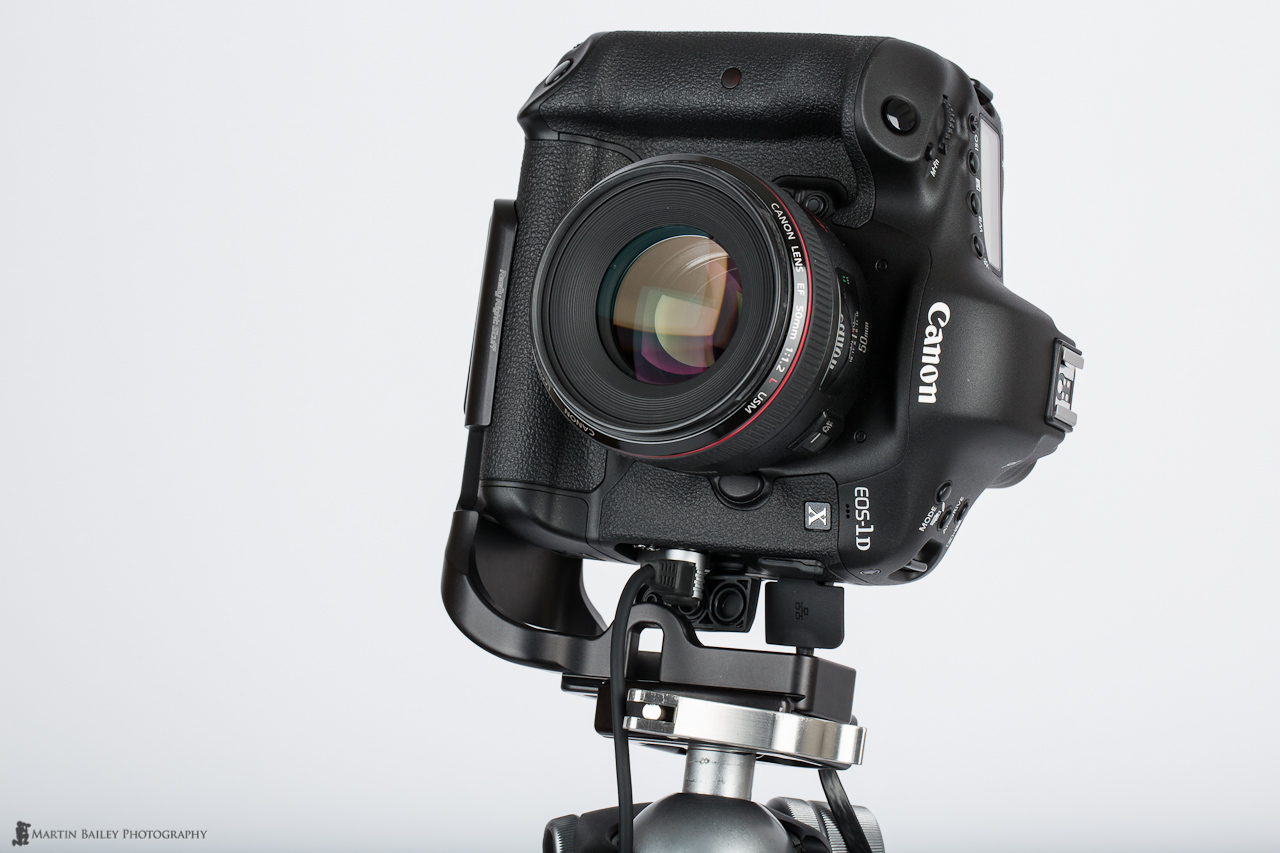 1D X L-Plate with L Component Extended & Cables Attached[/caption]
1D X L-Plate with L Component Extended & Cables Attached[/caption]
It's most useful in the portrait orientation of course, and not really necessary if you don't intend to mount the camera to a tripod in this position, as all cables can be inserted with the L-Component flush to the camera, but it does making plugging them in a little easier too, so is still useful even in landscape orientation.
Of course, if you are only plugging in a cable release, all Really Right Stuff L-Plates have clearance for that, so you can use a cable release in portrait orientation without extending the L-Component and still be able to mount the camera on a tripod.
[caption id="attachment_6453" align="aligncenter" width="590"] 1D X with L-Plate in Portrait Orientation with Cable Release Attached[/caption]
1D X with L-Plate in Portrait Orientation with Cable Release Attached[/caption]
Another nice new feature, especially important now that we might be unscrewing and adjusting the L-Component in the field, is a hole in the base plate to stow the hex-key (below). I have it resting in the hole in this photo so that you can see it, but you just slide the key right in there, and it's held in place with a small magnet.
[caption id="attachment_6456" align="aligncenter" width="590"]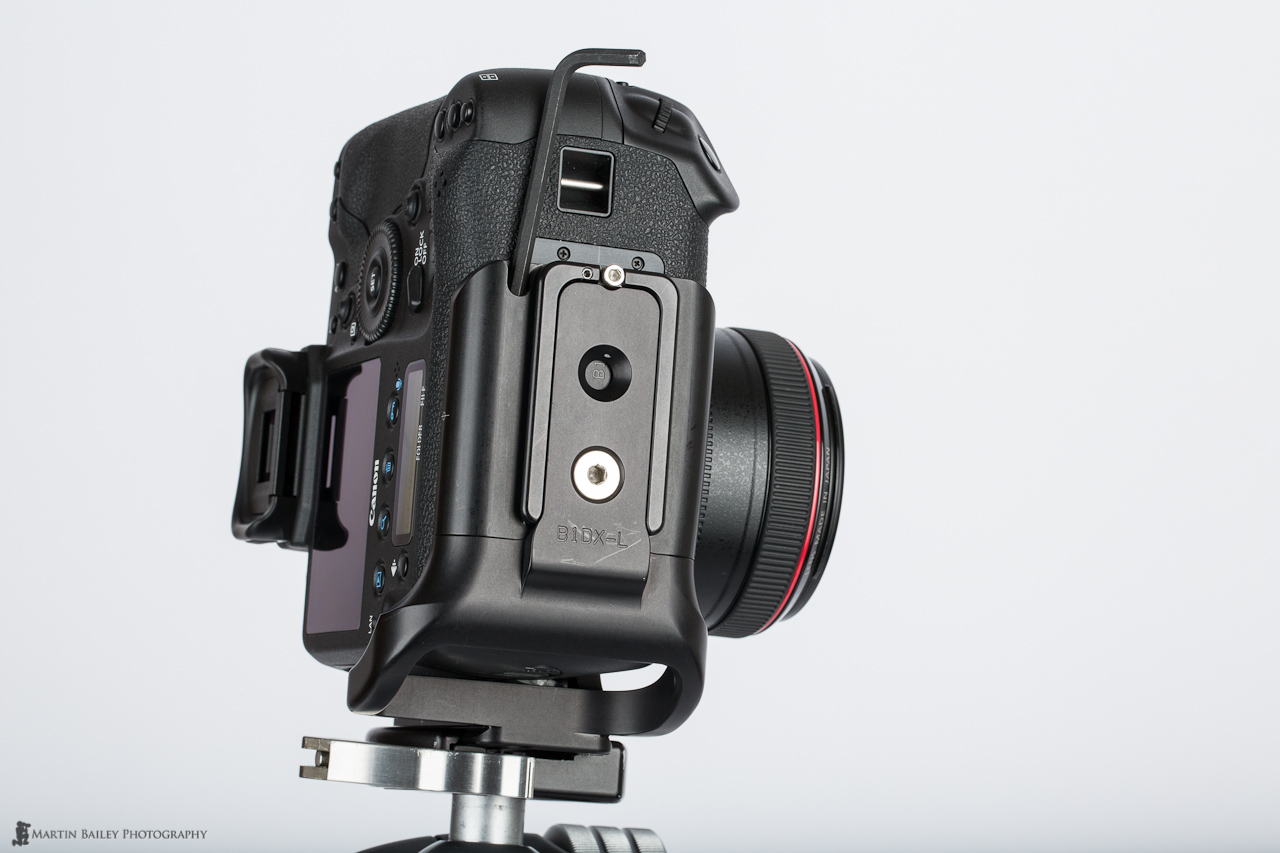 1D X L-Plate and Hex Key[/caption]
1D X L-Plate and Hex Key[/caption]
And before we move on, here's a bottom view (below) with Hex-Key stowed and the L-Component of the plate extended, so that you can see exactly how this works.
[caption id="attachment_6455" align="aligncenter" width="590"]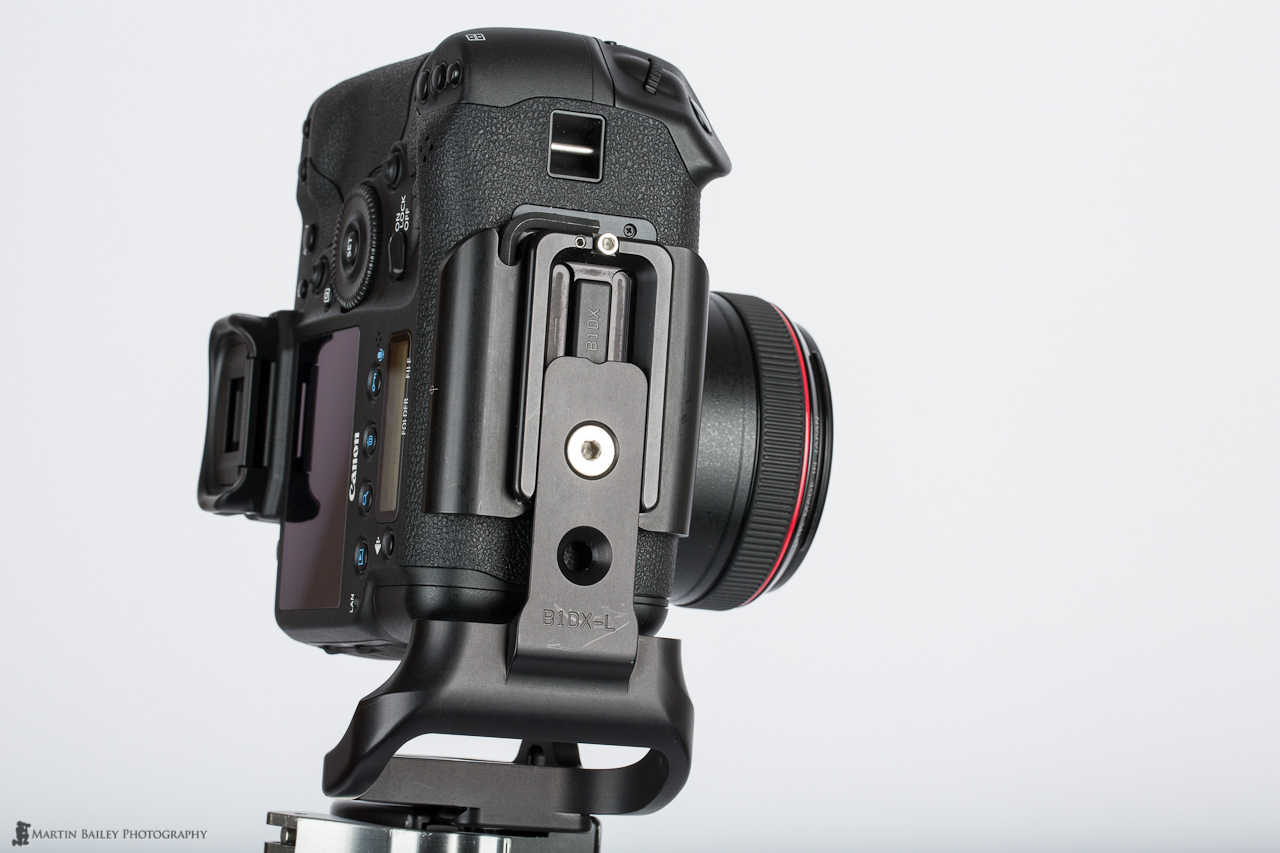 1D X L-Plate with L Component Extended[/caption]
1D X L-Plate with L Component Extended[/caption]
The 5D Mark III's L-Plate, the BGE11-L is made specifically for the 5D Mark III with the battery grip fitted. Really Right Stuff also do a plate for just the 5D, without the Battery Grip, but I like the larger form factor of the grip, and so this is always my choice.
[caption id="attachment_6452" align="aligncenter" width="590"]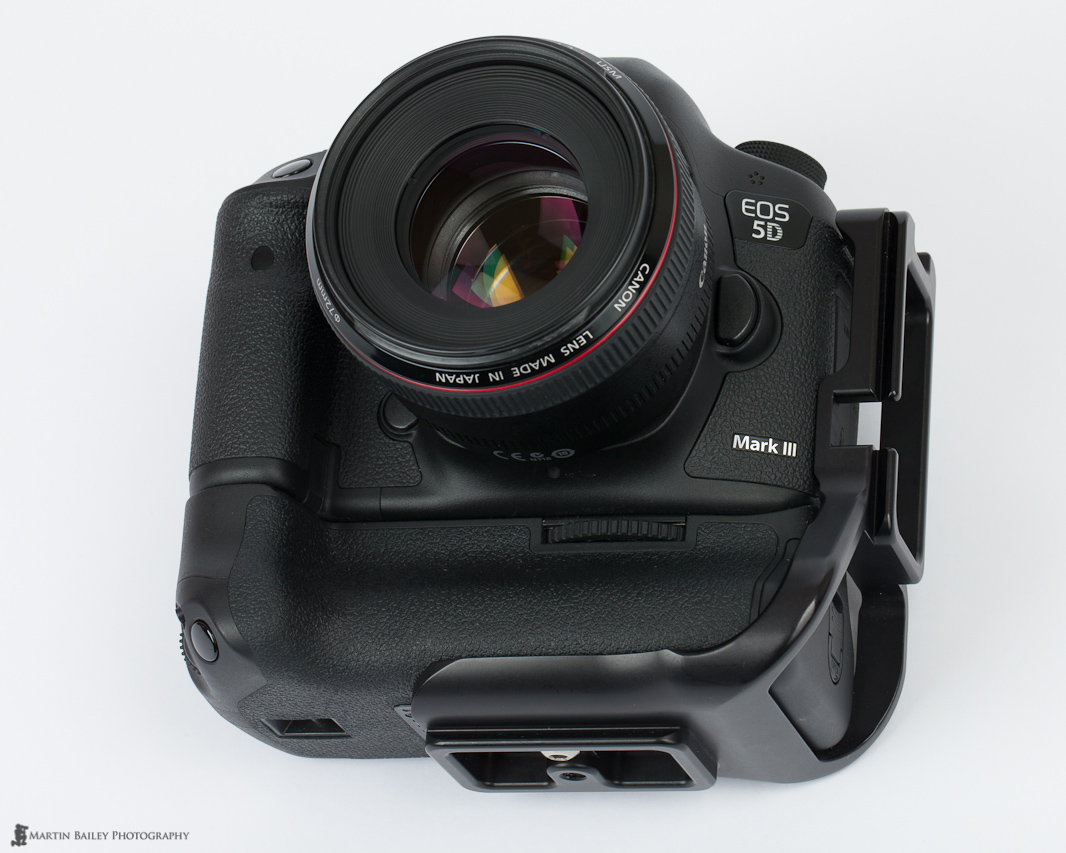 5D Mark III with BGE11-L Plate Fitted[/caption]
5D Mark III with BGE11-L Plate Fitted[/caption]
The 5D Mark III L-Plate is not modular, like the 1D X plate, but it's been redesigned to allow you to remove the battery pack, as this is now accessed from the side of the battery grip, not the back as with the 5D or 5D Mark II. And, of course, you can plug in your cable release (below) without hinderance and mount the camera in portrait orientation with the cable release plugged in as necessary.
[caption id="attachment_6457" align="aligncenter" width="590"]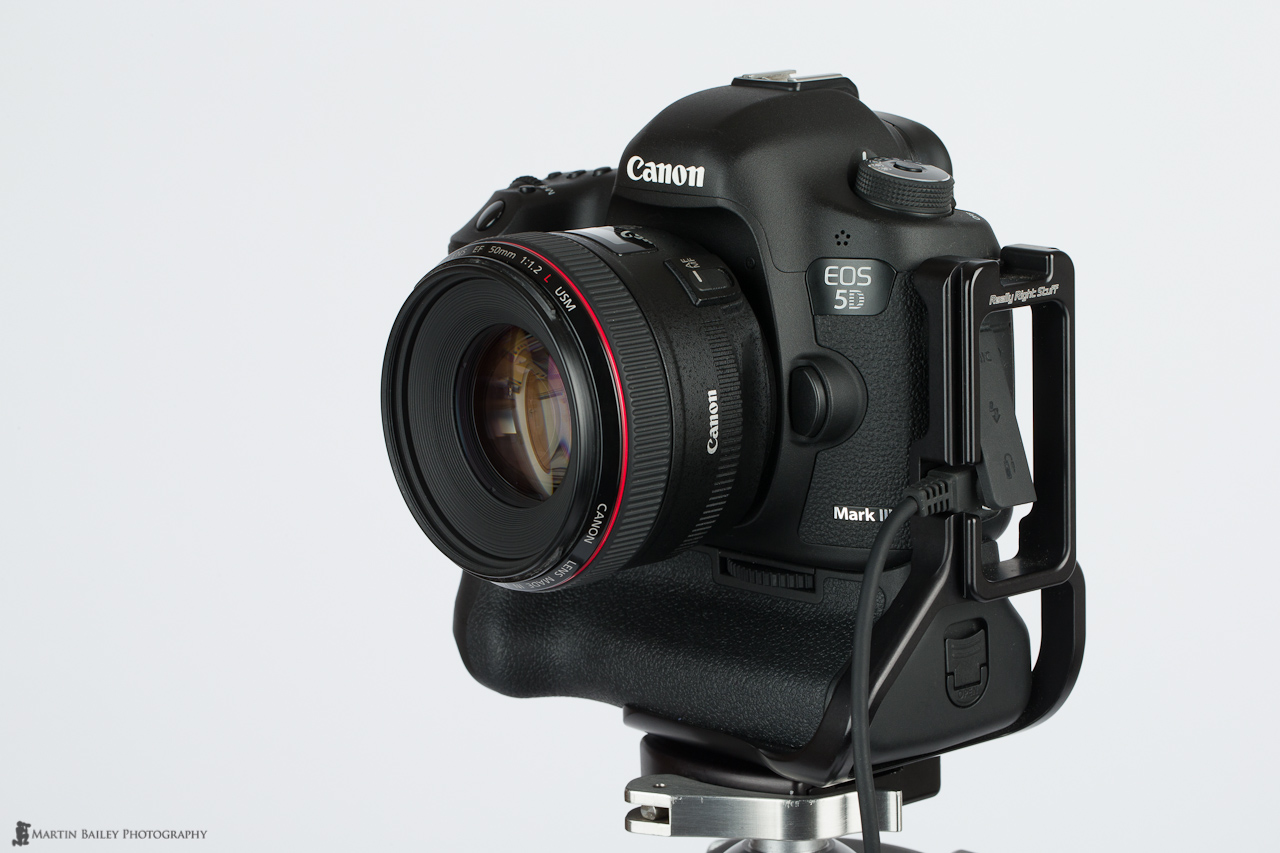 5D Mark III with L-Plate & Cable Release Fitted[/caption]
5D Mark III with L-Plate & Cable Release Fitted[/caption]
I buy lens plates for the tripod shoe (below) on all of my longer lenses, or even my macro lens that has a collar and tripod mount, and this allows me to mount the camera to the tripod via the lens, rather than the camera. This is especially important with long lenses, that tend to come with the tripod collar and shoe, because if you mount this long a lens to the camera while the camera is attached to the tripod it would put a huge amount of stress on the camera mount, and for super telephoto lenses, you may well even rip the mount out of the camera. It would of course also make your system less stable, and give rise to camera shake as well.
[caption id="attachment_6458" align="aligncenter" width="590"]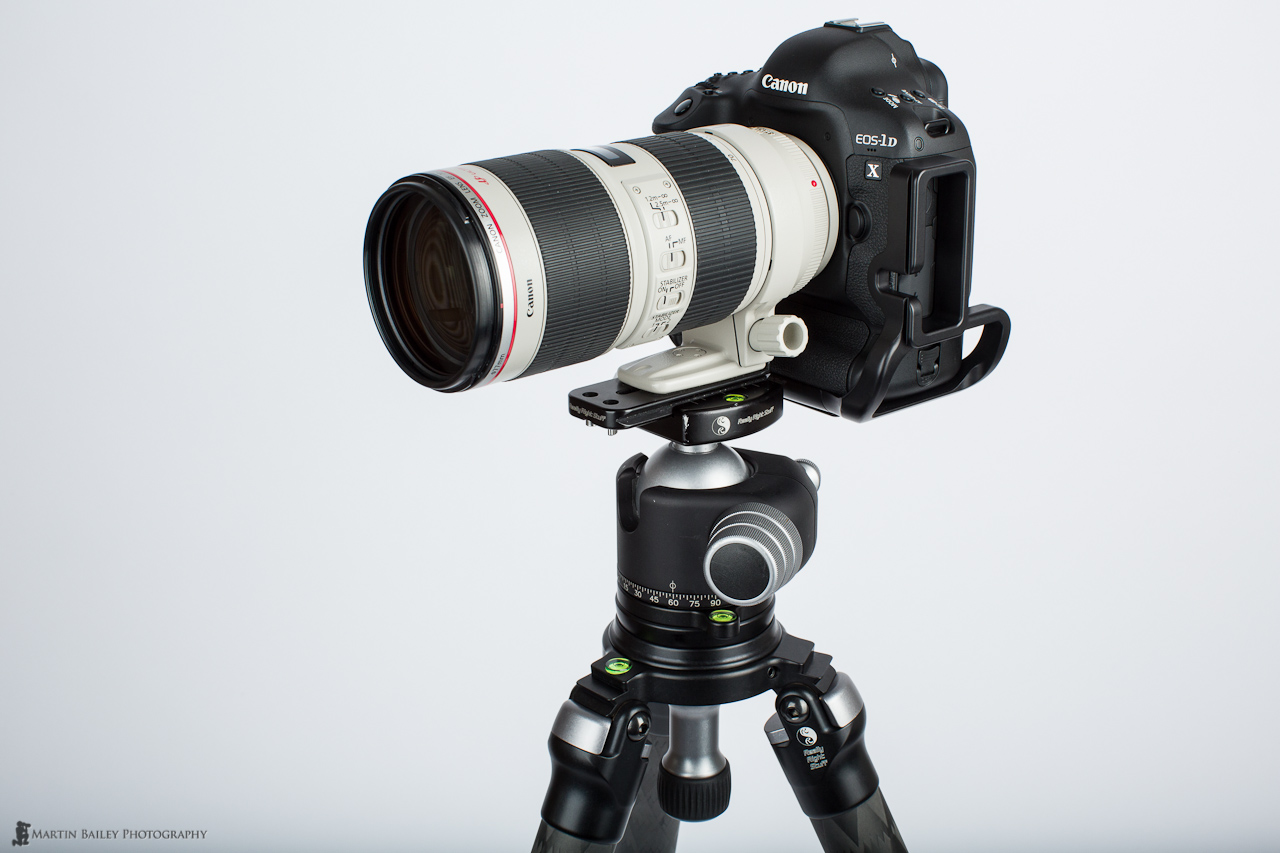 70-200mm Lens Mounted with Tripod Shoe[/caption]
70-200mm Lens Mounted with Tripod Shoe[/caption]
Of course, with the lens mounted, to go to portrait orientation, you just loosen the screw on the lens collar, and rotate the camera and lens, once again, keeping the center of gravity all down the center of the tripod, for maximum stability.
Because all of my cameras and long lenses are fitted with plates, it means that everything is interchangeable. You might remember that back in Episode 288 I showed you how I fitted my Black Rapid Double Strap with Really Right Stuff Quick Release Clamps, so that I could quickly switch from tripod mounting to my straps.
[caption id="attachment_6460" align="aligncenter" width="590"]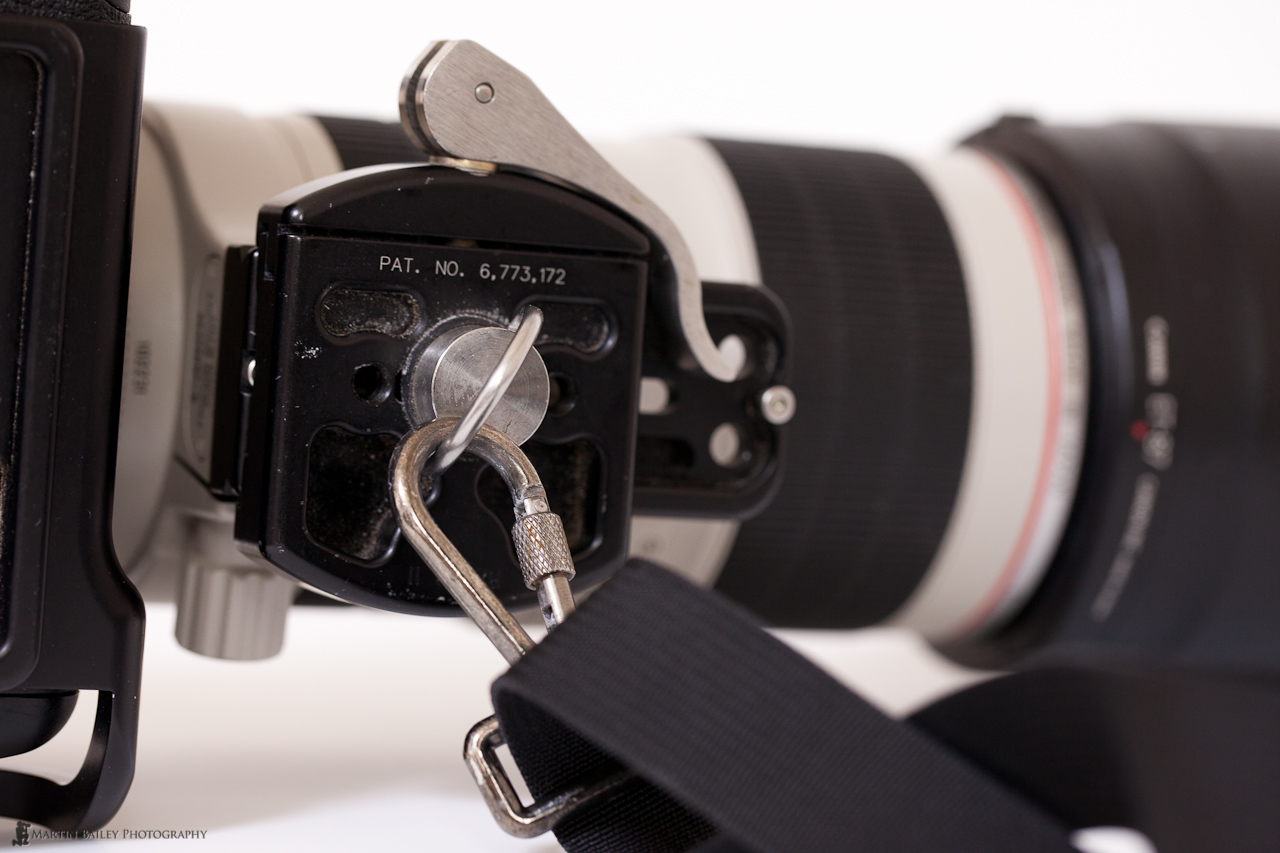 Really Right Stuff Quick Release Clamp[/caption]
Really Right Stuff Quick Release Clamp[/caption]
I also now use the Optech/USA straps so that I can remove the strap and pass the shorter remaining strap through the Black Rapid strap, to stop the camera falling to the ground, as it's done a few times while walking around or sitting in Zodiacs with the strap attached to the lens. Take a look at Episode 288 if you want more information on this.
I also use a Wimberley Gimbal Head with my 600mm f/4 lens, and that works fine with the Really Right Stuff dovetail plates. And, although it broke and I never replaced it, I used to have a monopod with a Quick Release clamp fitted, and that was nice too, to be able to just switch between all of my support or carrying devices without having to unscrew and switch out the plates on anything.
[caption id="attachment_6448" align="alignright" width="341"]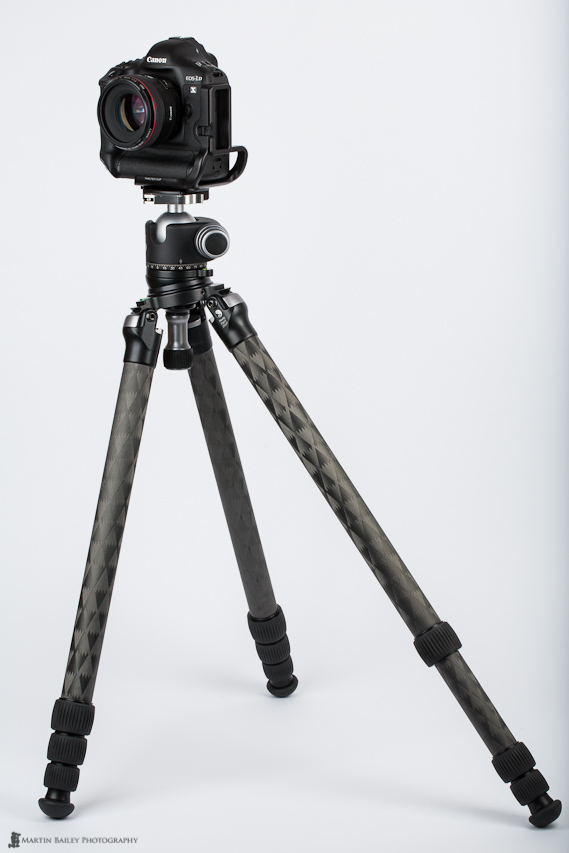 TVC-34L Tripod with Leveling Base Correcting Unlevel Tripod[/caption]
TVC-34L Tripod with Leveling Base Correcting Unlevel Tripod[/caption]
So, last but not least, let's take a look at the Versa TVC-34L Tripod with the Optional TA-3-LB Leveling Base (right). Really Right Stuff make Series 1, 2 and 3 tripods in the Versa range, with 1 being the lightest, 2 being more sturdy, and Series 3 being the most robust. They are of course all engineered to the same high standards, but tripods are always a trade-off between size and weight, and their stability. If you only intend to use your tripod with a mirrorless micro four-thirds camera for example, there isn't much point in going for Series 2 or 3, but if like me, you use large heavy lenses and heavy professional bodies, you might want to consider a Series 3 Versa Tripod.
Selecting a Tripod
Long time listeners will probably recall me talking about things to bear in mind when selecting a tripod, and I of course bore these things in mind when I ordered my 34L too. Firstly, you want the tripod to get your camera's viewfinder to eye-level, without having to use a center column. Raising the center column makes the tripod less stable.
If you think you're going to want to set the camera higher than eye level, consider doing what I did, and buy a tripod even taller than yourself. I'm 5'10" (178cm) and this tripod gets my cameras' viewfinder to eye-level without extending the bottom leg section. Having that extra height though, will allow me to extend the tripod further, if for example, I want to shoot something overhead, looking up into the viewfinder, or using LiveView.
It also enables me to extend one or two legs further when shooting on a steep slope, or with a leg in a river etc. The other things I've mentioned in the past is that in deed snow, the legs can sink, and it's nice to be able to compensate for that. At events, if you take some step ladders, you can fully extend the tripod and stand on the steps, shooting over peoples' heads. As you can see, there are a number of reasons why getting a larger tripod can help your photography. It is of course, a trade off on weight too though. Take a look at the extended height of the tripods, and bear in mind that you will add the height of the ball-head, and your camera, to the viewfinder, to get something that you don't have to bend over to look into.
Leveling Base
I selected the 34L tripod without a center pole, and instead added the optional TA-3-LB Leveling Base (bel0w). As you can see in the last photo (above), it allows you to level the tripod head, even if the legs are on uneven ground. Of course, in this photo I simulated this by extending one leg further than the others, but you can also see how I was able to correct this. You turn the short pole extending out of the bottom of the leveling base to loosen it, straighten it according to the built-in spirit level, then turn the pole back to tighten it and lock the base in position. It will apparently adjust for up to 15° of tilt, which you can see from these photos is quite significant.
[caption id="attachment_6449" align="aligncenter" width="590"]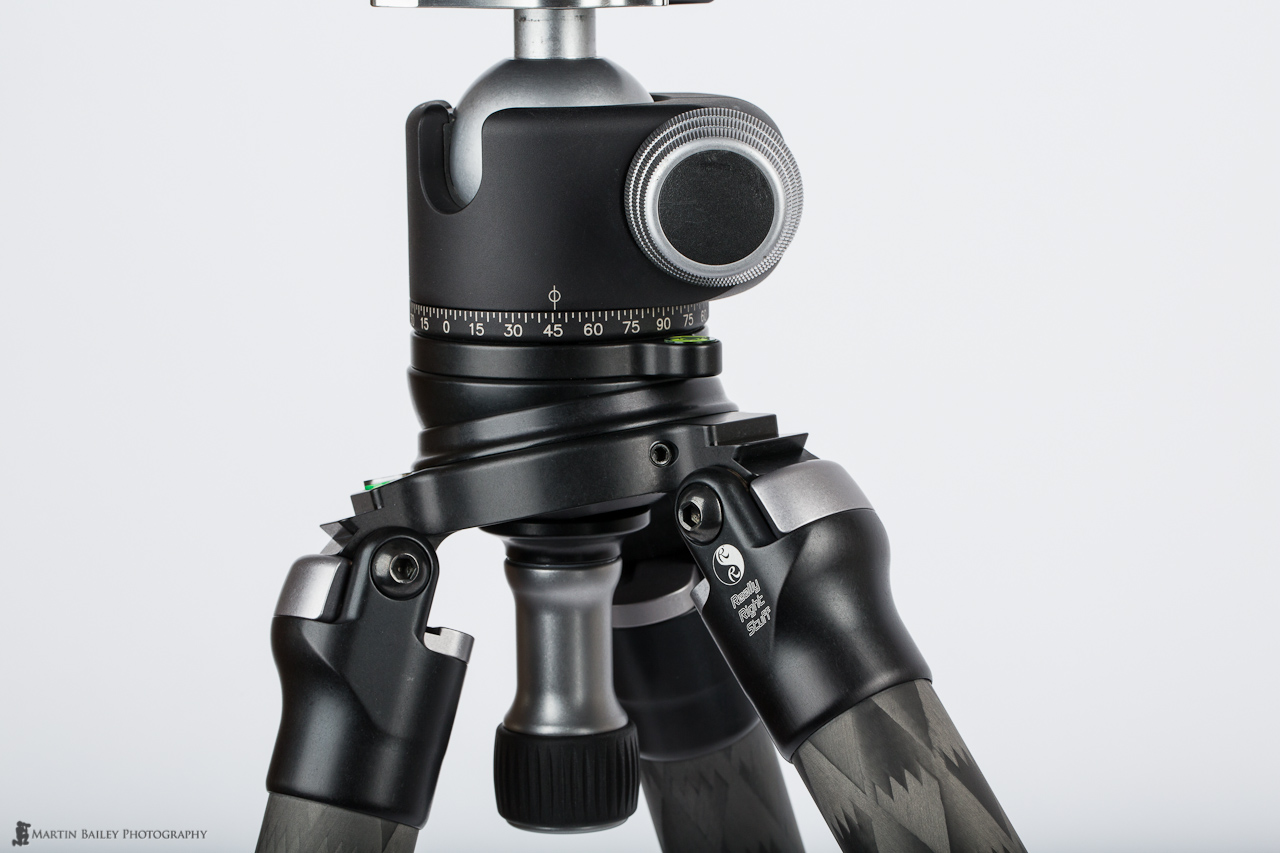 Leveling Head Tilted Over[/caption]
Leveling Head Tilted Over[/caption]
You might be wondering why I wouldn't just allow the ball-head to be at an angle, and correct the camera with the ball-head itself, but this goes back to what we mentioned earlier, about panorama photos. With the base level, you can unscrew the horizontal movement screw on the BH-55 and just turn the camera on the base, and keep your horizon straight as you shoot your series of panorama shots. To do this without the leveling base, your only other option is to adjust each leg until you get the tripod straight, but that takes a lot more time.
We can also see in this next photo, that the pole extending out of the bottom of the leveling base does not touch the floor when you have the tripod set to it's lowest level, by splaying the legs out to their full extent.
[caption id="attachment_6450" align="aligncenter" width="590"]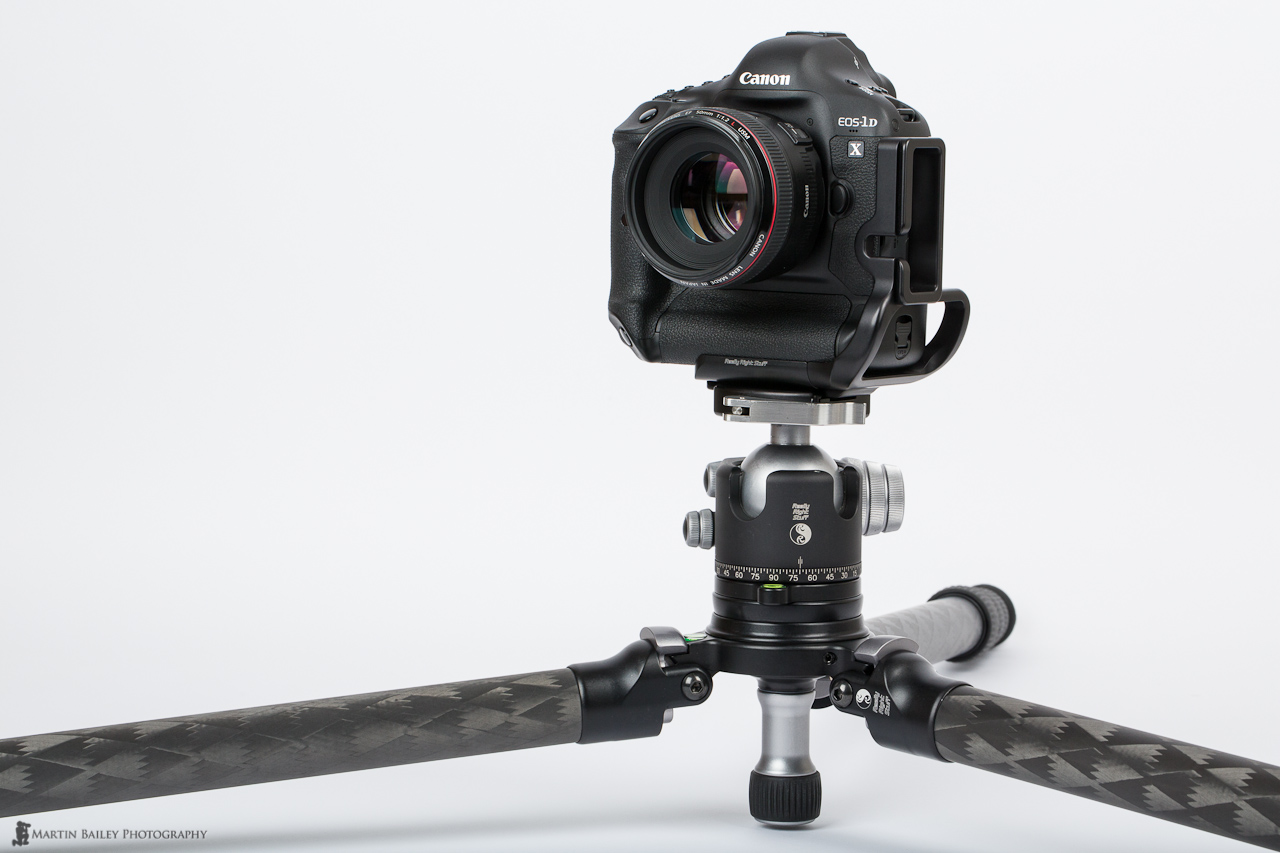 TVC-34L Tripod with Leveling Base at Ground Level[/caption]
TVC-34L Tripod with Leveling Base at Ground Level[/caption]
Why Do I Need a Sturdy Tripod?
Of course, the reason you'll want a big sturdy tripod is to keep your gear rock solid during your exposure. I do a lot of long exposures, and you really need a solid tripod to avoid camera shake once you slow your shutter speed down. Even for normal speed exposures, if your ball-head and tripod shudder as your shutter unit moves, you're going to end up with blurred images.
Longer lenses are heavier and therefore obviously need a more sturdy tripod. The 34L will support up to 50lb / 23kg in weight, which is enough for even the biggest lenses, but long lenses can shudder during exposure, so I also use a Really Right Stuff Lens Support Package, to support the front of the lens as I shoot, which reduces that shudder a lot. Here's a photo from Episode 198 in which I talked about this lens support system.
[caption id="attachment_6465" align="aligncenter" width="590"]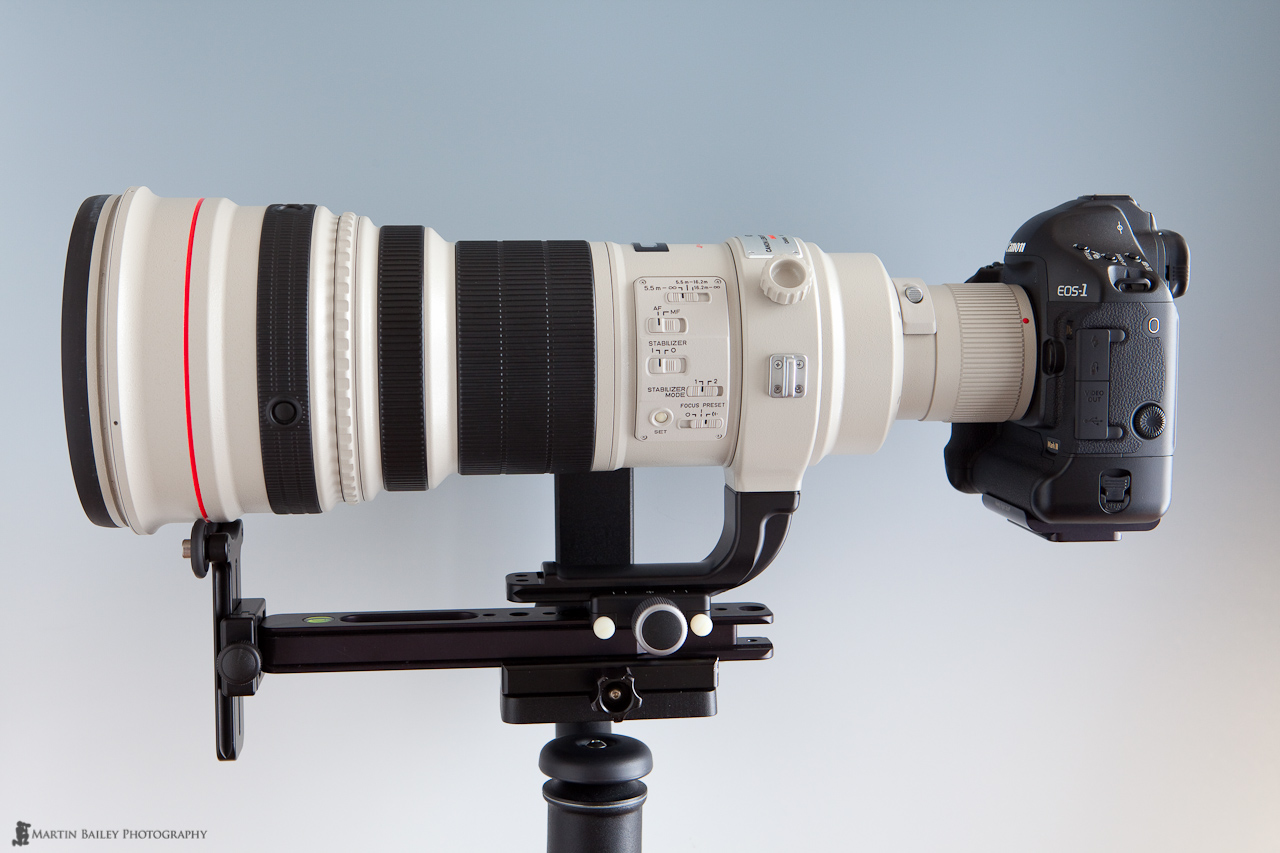 600mm F4 with Long Lens Support CP-YS-QR-Pkg[/caption]
600mm F4 with Long Lens Support CP-YS-QR-Pkg[/caption]
You can see I also use the Really Right Stuff Replacement Foot! This really is a Really Right Stuff love-fest!
What Was Wrong With My Gitzo?
I was asked what was wrong with my trusty Gitzo 3 Series Tripod, and why I replaced it, so I should say for the record that I still believe that Gitzo make incredibly good tripods. I was always happy with the sturdiness of my Gitzo coupled with the BH-55 ball-head. The problem was that a few months ago, one of the legs started to rotate at the top of the first section, making it difficult to loosen and tighten the legs to extend or retract them. I'll be keeping the Gitzo too. I just had to sent it in for repairs, and didn't expect it to be returned before I leave for the US to continue my Pixels 2 Pigment workshops.
Having said that, now that I own a Really Right Stuff tripod, I can't see me going back. In true RRS style, the TVC-34L Tripod is an engineering work of art. Even down to how the latches ratchet back out as you bend the legs back in out of the low angle mode, is magical. They've thought of everything, and I'm very pleased that I took the plunge. The only thing that I will have to work around is that without the center pole, I am not able to flip the pole around and hang the camera below the tripod for super low angles and macro work. I guess when I leave the house to do that kind of photography from now on, I'll continue to reach for my old trusty Gitzo.
The Trade Off - Your Choice
Just to recap, larger, sturdier tripods are always a trade-off with regards to size and weight. If you are going to be traveling or even trekking of course, you might decide to go for a lighter, smaller tripod, and live with the lack of ultimate sturdiness, and even having to bend down to look through the view finder. It's totally up to you. My main advice here though, is weight up the advantages and disadvantages, and make your decision based on what you are able to carry. If you can carry, and have the budget for the larger more sturdy tripod, and don't have another reason to make that trade-off, then go the larger one. It will serve you well, I assure you.
Oh, and the same goes for the ball-heads. The BH-55 is Really Right Stuff's flagship model, but they do a series of smaller heads that are from what I can see also incredibly well made, so if you go for a smaller tripod, consider a smaller head too. There wouldn't really be much point in having a big fat BH-55 on top of their smallest tripod.
Quick Release Levers
One word before we finish, about the Quick Release clamps as opposed to the knurled knob clamps that Really Right Stuff also make. I'm asked regularly if I trust the quick release clamp, and if I think the knob might be better, or safer.
[caption id="attachment_6471" align="alignright" width="341"]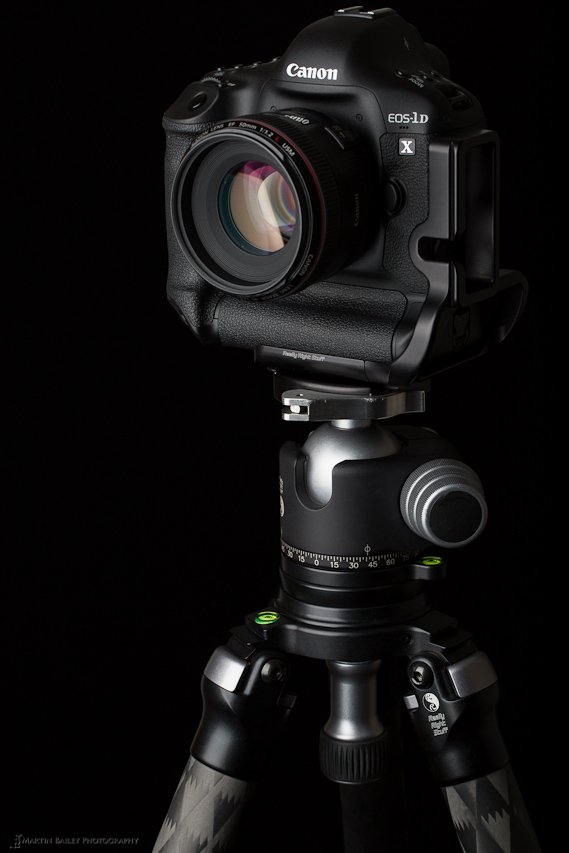 Really Right Stuff TVC-34L Tripod with Leveling Base and BH-55[/caption]
Really Right Stuff TVC-34L Tripod with Leveling Base and BH-55[/caption]
My reply is usually that I tried the knob release in the past, and didn't like it. It takes too long to switch out a camera or lens when you have to turn the knob, plus, in cold conditions it can be a pain, literally. I personally prefer the quick release aspect, and I have never once had one of these come loose, so yes, I trust them totally, even when dangling my gear from the Black Rapid Double Strap using the quick release clamps.
Simply the Best!
Really Right Stuff isn't the cheapest camera support system on the planet, by a long shot, but this is one of those occasions like many, when you really do get what you pay for. If you can make do with cheaper, that's great! But most people I know end up spending more money on camera supports than is really necessary because they start off cheap, and gradually replace their tripods and heads as they grow as photographers, and find inadequacies in their gear. I've done this myself, going through a number of tripods and ball heads over the years. If you read this early enough in your photographic life, you may even be able to save yourself a little money by just going for the best now, because that's what Really Right Stuff gear is, the best.
End Notes
Note that over the next month or so the Podcast release schedule is going to be all over the place, as I travel to the US, Canada and the UK for my Pixels 2 Pigment workshops. We still have spaces, so if you'd like to join us, please check out the www.pixels2pigment.com Web site and see what that's all about.
Also, I'm taking the opportunity of being in the US at this time to attend Photoshelter's Luminance 2012 Workshops and series of TED style talks from Sept 11-13. I'll be learning stuff from greats like Joe McNally and Zack Arias, which is going to be amazing! If you are also planning to go, do let me know, or search me out while you are there, so that we can meet face to face and shake hands.
Show Notes
Links to most gear is in-line above.
Music from Music Alley: http://www.musicalley.com/
 Subscribe in iTunes for Enhanced Podcasts delivered automatically to your computer.
Subscribe in iTunes for Enhanced Podcasts delivered automatically to your computer.
Download this Podcast in MP3 format (Audio Only).
Download this Podcast in Enhanced Podcast M4A format. This requires Apple iTunes or Quicktime to view/listen.
Gallery
Click a thumbnail to view the images from this post with limited shooting info. Once the image has opened, you can navigate back and forth with your keyboard arrow keys or by clicking the image.
[gallery link="file"]
